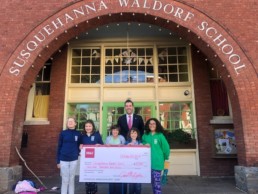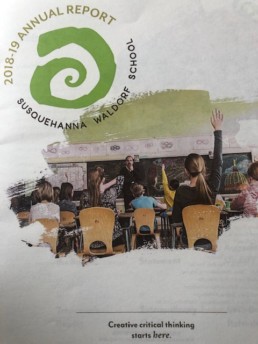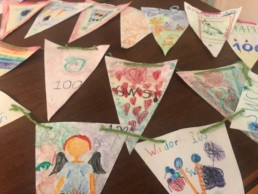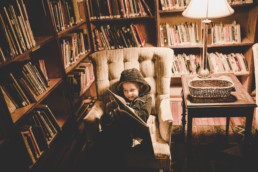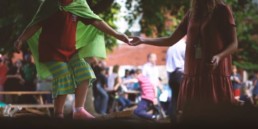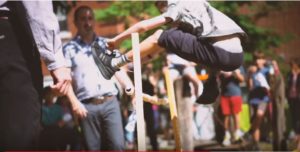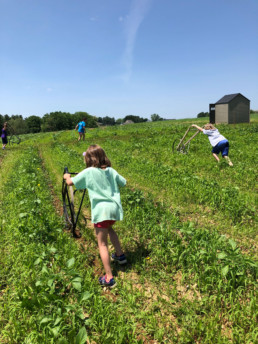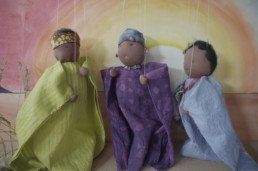Right Now I Feel: A Mindfulness Practice
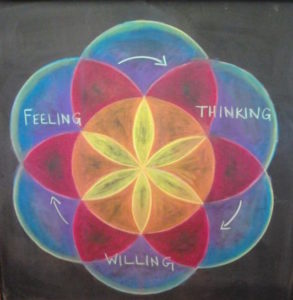

A "Waldorf Wellness" Blog Series to Help You Build Resilience
Right Now I Feel
How are you feeling right now? I mean this quite literally, if you closed your eyes for the next ten seconds and checked in and had to choose just ONE word from that inner-listening, what would it be?
Right now, I feel ________________.
It’s ok if you don’t quite know. It’s ok if the idea of narrowing down your complex emotional state to one word feels impossible. There is no “right way” to cope with the trauma, turmoil and anxieties of a crisis. What IS important is that we do SOMETHING to get our inner states to shift. And often this something can be a simple as a quick check in:
Right now, I feel________________.
In the midst of a crisis we can easily (and understandably) get caught up in a whirlwind of emotional overload. We are thinking about our stability on so many levels. We are thinking about the wellbeing of our families, the safety of our children, the health of our elders. We are thinking about things we have never had to actually think about like breathing, social distancing, meticulously disinfecting, quarantining, distance learning, staying in place. We may be thinking about those who are not thinking about these measures.
Humankind exists because of these thoughts/instincts about how to survive. Our Central Nervous System (CNS) is hard-wired with functions to ensure that when a threat is posed to our safety, protective factors come online quickly to defend our ability to stay safe. Our Sympathetic Nervous System (SNS) is one of these protective brain/body functions. When this system is activated, it prepares us to FIGHT or FLEE from dangerous situations or people. Our Parasympathetic Nervous System (PNS) might come online and tell us to FREEZE when we are totally overwhelmed by a situation that feels out of our control.
If you were able to answer the question: Right now I feel____________, what is the word that came up for you?
(Here is a brief list of feeling words if you need some inspiration: Exhausted, confused, silly, morose, helpless, optimistic, bored, frustrated, annoyed, inspired, motivated, distracted)
What’s the point?
I have found myself feeling “stuck” and “overwhelmed.” These are examples of a FREEZE survival response.
If you said “angry” or “irritated,” these are examples of a FIGHT response.
If you said “anxious” or “afraid,” these are examples of a FLEE response.
What I hope to offer you is the BIG EXHALE that all of this is normal and -- in fact -- these reactions to a crisis are the building blocks for our ability to cultivate RESILIENCE. If we can pluck JUST ONE feeling from the whole tornado of emotions that surface as we navigate this crisis, we have something to respond to with intention and compassion. We can get a little unstuck, we can soften our anger, we can calm our anxiety if even for just one moment.
When we turn a thought into a word we have more power to get out of instinctual/survival-mode. We can actually FREE UP a little room in our brains/minds (and therefore in our bodies and our spirits because it’s all connected) to help us move forward feeling a little calmer and a little more in control.
A Family/Community Wellness Practice
Try this “Right now I feel” exercise with your family members.
- Sit in a circle and each take a turn saying “Right now I feel_______”
- Then, each person can spend five or so minutes sharing/exploring why that feeling is there -
- Could this feeling be because you miss your friends at school?
- Do you think your feeling came up because grandma is sick?
- Or because of stress learning how to work and learn from home?
- After each person shares their “exploring why” a feeling has come up, go around the circle one more time.
- Each person shares again: “Right now I feel________”
- Has anything changed? Did a new word come up? Just pause to reflect quietly as a family or community.
- That’s it!
Sometimes moving forward in a hopeful way has nothing to do with doing a whole bunch of stuff! Simply working with ONE moment in time and ONE feeling can be really empowering and enlightening. Give it a try and let me know what you think!
I’ll offer some more “clearing” practices (including art therapy projects!) in this Waldorf Wellness blog post series so that we can continue to build resilience and connection, and inspire hope as individuals, families, and as a Waldorf Community.
With Warmth and Support,
Diane Richards, Development and Alumni Coordinator
Diane Richards is a former K-12 Visual Arts Teacher, a Trauma-Aware Yoga and Mindfulness teacher and is a graduate student studying psychotherapy at Widener University
SWS Financial Aid Program supported through BB&T's EITC gift
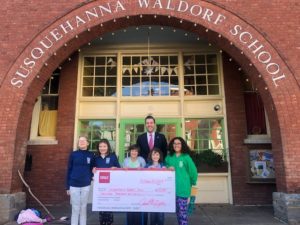

“BB&T is proud to continue its unwavering support of the Susquehanna Waldorf School, its amazing students, and devoted staff. Waldorf is on an incredible mission, and we are honored to be one of their many partners along the way,” says Mr. Malfregeot.
BB&T’s continued support allows more students to afford Susquehanna Waldorf School, where the arts, creativity and imagination are woven into every aspect of academics. “EITC donations directly support the financial aid program at SWS, thereby allowing more students to afford to attend the school. SWS is shaping well-rounded human beings- our future leaders. Donations like that of BB&T impact so many lives- today and in the future,” says Board of Trustees member, Ernie Schaefer. 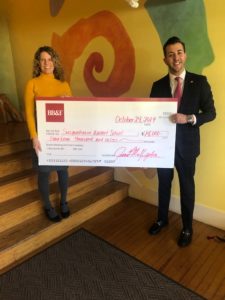

EITC is a program providing tax credits to eligible businesses contributing to a Scholarship Organization, an Educational Improvement Organization, and/or a Pre-Kindergarten Scholarship Organization. Businesses, as well as organizations receiving the EITC funding, must apply and be approved by the Department of Community and Economic Development to participate.
About Susquehanna Waldorf School: SWS is a Nursery through 8th grade school serving students in Central Pa. Waldorf education recently celebrated its centennial anniversary- the first Waldorf school opened in Germany in 1919. SWS opened its doors locally in 1987, and provides a rich and challenging environment that inspires its students to reach the highest level of intellectual, spiritual, artistic and physical achievement. Through the integration of these pursuits, the potential in each child is nurtured to fully develop his/ her unique capacities. SWS aims to instill a lifelong love of learning and a sense of compassion that benefits them, their community and the world at large.
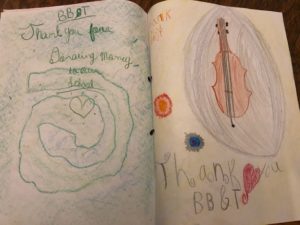

About BB&T:
BB&T is one of the largest financial services holding companies in the U.S. with $230.9 billion in assets and market capitalization of approximately $37.6 billion as of June 30, 2019. Building on a long tradition of excellence in community banking, BB&T offers a wide range of financial services including retail and commercial banking, investments, insurance, wealth management, asset management, mortgage, corporate banking, capital markets and specialized lending. Based in Winston-Salem, N.C., BB&T operates more than 1,700 financial centers in 15 states and Washington, D.C. and is consistently recognized for outstanding client service by Greenwich Associates for small business and middle market banking. More information about BB&T and its full line of products and services is available at BBT.com.
BB&T and SunTrust are coming together in a transformational merger of equals to create Truist, the premier financial institution in the country. The combination of these two iconic franchises will create the sixth-largest U.S. bank with 275 years of combined history.
THANK YOU BB&T!
2018-19 Annual Report
This academic year began with (a new Nursery program and) 3 full Kindergartens and Grades 1-8. SWS has not had a full complement of classes in 8 years. Our beloved building is full of joyful noise! (from Treasurer's Report)
DOWNLOAD 2018-19 ANNUAL REPORT
"Our world could only benefit from an institution that hosts and 'births" such well-rounded, community-minded and reverent new leaders."
- SWS Parent
100 years of Waldorf Education!
Waldorf Education founder, Rudolf Steiner, formed the first Waldorf School in Stuttgart, Germany in 1919. Today there are over 1,100 Waldorf schools and almost 2,000 Waldorf kindergartens in 80 countries around the globe.
In celebration of Waldorf education’s centennial, Susquehanna Waldorf School joins other schools worldwide engaging in social and environmental impact projects. The higher aim is to regionally and internationally create a vital interconnectedness essential in today’s world.
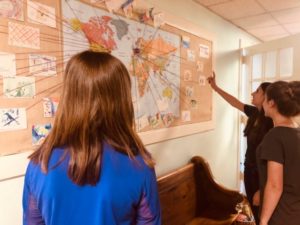

Two of the projects that SWS has participated in over the past year are: The Worldwide Postcard Exchange and the Greenbee Wildlife Web. SWS students joined Waldorf students from around the world in a global postcard exchange initiative to both broaden the perspective of students and to celebrate the 100th anniversary of Waldorf® education. Students in every Waldorf school around the world are sending a postcard to every other Waldorf school. Each postcard is individually designed by a young person, telling or showing something of his or her country, school of self. All the postcards received at SWS are rotated through a world map display, showing where each card originated. The visual representation allows students to see where these connections are- near and far.
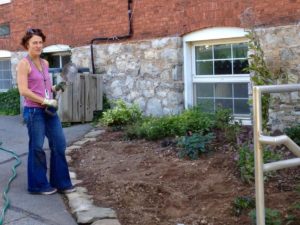

As part of Waldorf’s ongoing mission to create a more sustainable future, schools across the globe are taking action to support pollinators (honey bees, butterflies, moths and more) as part of the Greenbee Wildlife Web. At SWS, students, parents and faculty came together to plant several pollinator plants and shrubs around the campus over the summer. SWS representative Michelle Wann states, “SWS students in the third grade will care for the plants as part of their farming and gardening curriculum, as well as the fifth graders, who are studying Botany”. The school says this project supports Waldorf’s ‘three-fold mission to protect and preserve the honeybee and all pollinators, create a more sustainable future for our planet’s ecology, and teach our children to be good stewards of the earth’.
All the campaigns aim to stimulate dialogue around human values in education and support initiatives that revitalize society and our relationship with each other and our earth. An introduction video to Waldorf education and its centennial celebration can be found here: Waldorf 100: Learn to Change the World
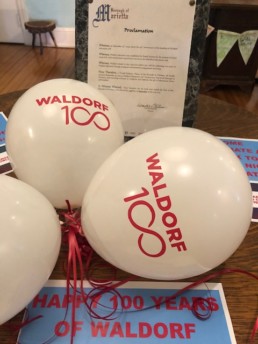

SWS Brand Refresh: Reflecting on Our History, and Looking Ahead
“Our logo makes a statement about us—our inner and outward expression of the organization’s goals and values. Our logo exists in many places beyond the school website. It has recognition in the market and deep associations with other Waldorf schools. The logo lives soundly with many communities that we serve.” SWS Alumni Parent
Years ago, a logo task force (consisting of SWS School Board members and faculty, along with numerous passionate parents) set out to create a logo/brand for the school. Their purposeful work meant identifying the core values of the school- what it stood for then and what they wanted to carry forward into the future. They knew they wanted the logo to show incarnation of our children and to have a presence within nature and to make sure it included our inexhaustible inner light. “We did not want a snappy marketing icon.” The SWS logo carries with it deep and meaningful roots.
The spiral that our logo is known for was found originally as a petroglyph, discovered on Walnut Island (Lancaster County) in our beloved Susquehanna River. Alone, the petroglyph offers a deep, simple, intrinsic truth, a feeling of permanence and longevity, of geological relevance and sacred geometry. The inner coil of light was placed in a square box because of the beauty of its paradox, but also as the expression of the inner and outer community relationship in a continuum.*
Over the last year, SWS has carefully undergone the process of updating our school website. Not only did we want to be more user-friendly and accessible, we also wanted our “brand” and outward messaging to reflect who and where we are as a school. The new website, launched in late October, reflects a maturing school. Through beautiful imagery, the site highlights the work of community and the work of our developing children, while also leading new families through the value of Waldorf education. The gently updated logo is supportive of this as well. Holding to the foundational elements of the spiral and its color, the logo also reflects the colorful, warm energy presently elevating SWS into a bright, prestigious and sustainable future: honoring our school’s past, nurturing the lives of children and families today and looking ahead with united spirit in community.
This piece is an excerpt from our 2018-19 Annual Report. Read the full report here.
*Source: “From the Heart of the Task Force: An introduction to our New Logo.” June 1, 2004. Read the original "From the Heart of the Task Force: An introduction to our New Logo" article here.
A Healthy Diet for the Digital Age
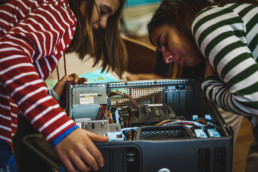

“Where do you see or use computers in your life?” Fausto Rivera asks the seventh grade class at the Susquehanna Waldorf School. At first, the students ponder the question quietly, exchanging a few thoughtful glances with their peers as they ponder their responses. “ATMs,” one student announces. “Toll booths,” another adds. “Cars.” “Phones.” “Healthcare.” What begins slowly quickly mounts into a lengthy list of daily applications for the technology. “These are fantastic answers!” comments Mr. Rivera. “Now, let’s actually open a computer up, and see how it works.”
Led by the expertise of Mr. Rivera, an expert Technologist with a degree in Systems Engineering, the students take their Cyber Civics program above and beyond the textbook. Separating into two groups, the students, without the aid of any tools, are tasked with opening up computers and locating various vital components that have been discussed throughout their study. The Cyber Civics course isn’t only about being able to understand the physical parts. It is approached the same way any other subject is undertaken in Waldorf education: by understanding what, how and why they use something, from the inside out. Aside from this study, computers are not present in early childhood and elementary Waldorf classrooms, and media use in ge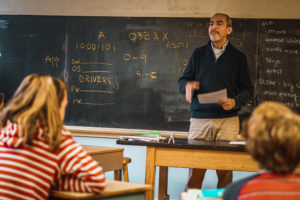

In the case of computers in the Cyber Civics course, the goal is to understand the history, evolution and physical components of computers, weaving everything together into a complete picture so that students can use the technology safely, effectively, creatively and wisely and grow into healthy, ethical digital citizens. “For a child, a computer is merely a toy,” says Leilani Richardson, Class 7 teacher. “At this age, and as they begin to enter adulthood and have more responsibilities around life, students now use 

As the class nears its close for the day, the students engage in a final hands-on exercise. Mr. Rivera asks the class to gather around as he lifts the lid to a computer server and presses the “on” switch; instantly, the server whirs to life, small orange and green lights twinkling across the board like a miniature city. “If you are going to teach Civics,” says Matt Bei of the New York Times, “then as part of Civics you ought to be teaching media.” At a time when the presence of digital media permeates seemingly every sphere of life, with children (and adults) around the world being conditioned to passively let technology control them, teaching young students that they can make healthy choices around computers has enormous implications for their own well-being, as well as the well-being of the greater community.
A Festival of Courage and Hope
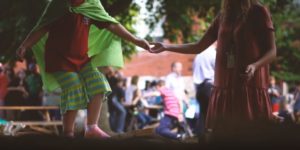

The Susquehanna Waldorf School gymnasium vibrates with the rumble of drumming and the stomps of a fierce dragon. He marches, each heavy foot falling with the beat, towards Saint Michael at the center of the floor, standing bravely with his sword. The dragon lunges as his shadow falls over the brave warrior, knocking him back. A hush falls across the surrounding villagers. In a moment, though, Saint Michael is on his feet again, and as the day settles into dusk, worries of the fearsome, destructive dragon are dissolved with the dragon’s defeat. Hope prevails.
The dragon, of course, isn’t a real dragon—it is Class 3, skillfully cloaked in layers of silky fabric—and Saint Michael isn’t the archangel himself but a brave student draped in a red cape and sparkling golden crown. The festival of Michaelmas honors Saint Michael, an archangel in Judaism, Christianity and Islam, and is observed by people of all faiths and spiritual paths. Waldorf schools around the world recognize this festival, which underscores the importance of overcoming fear and strengthening resolve, of finding the courage to face both internal and external dragons. That Michaelmas is celebrated near the autumn equinox is no coincidence: marking the diminishing daylight, close of the harvest, and shifting of seasons in the northern hemisphere, the festival comes at an appropriate time to remind students that they must endow themselves with courage and fortitude for the cold, dark days of winter ahead. Held near the beginning of the school year, the symbolic gesture towards the new journey of the year ahead is also significant, as each student takes on their own challenges.
After the Michaelmas play, students head outside for a series of field games and activities that focus on courage. The activities meet each student at a developmentally appropriate age: the younger children, for instance, balance a small pebble on a wooden sword as they tightrope a circle of logs; older students wield a javelin to collect large wooden stars; and all ages sprint to leap as high as they can over the high jump (with the bar rising after each success). The closing event, however, remains the favorite: an energetic tug of war that tests the strength and striving of students as they work together. It is through these efforts that students discover new inner resources to help them grow towards life and light, for now and into adulthood.
“Michaelmas is about rising, physically, to face your inner battles, your inner ‘dragons’,” says Class Five teacher Salvatore Martino. “This is a common theme in stories, from the fairy tales to the Norse mythologies.” In Waldorf education, it is these teachings of parallel stories to our own human challenges that speak to students in a symbolic way, identifying with a need shared by all for truth and for justice.
The tradition of class trips
“We LOVE to weed!” exclaim several second graders in Susquehanna Waldorf School teacher Rochelle Dietz’s class as they pluck the unwanted weeds from the soil at Heritage Creek Farm & Educational Center. The students, visiting the Center for their year-end class trip, are getting a taste of next year’s third grade curriculum on farming and gardening.
Multi-day curricular class trips in Waldorf education serve to expand the students’ world through hands-on experiences and direct observation. It is an active form of learning that corresponds to the classwork and deepens the understanding and relationship with the material. Class 4’s study of local history and geography, for instance, culminated in a trip to Ricketts Glen to experience the spectacular waterfalls and scenery of the Red Rock and North Mountains, as well as exploration of the region’s rich history of the once-booming coal mining industry.
But it’s not just the educational content that makes these trips so invaluable to the student’s growth.
From first through eighth grade, the students engage in progressively more challenging adventures, allowing them to not only use their knowledge in a contextual manner, but also to overcome their limits and expand their perspective. Things can get a bit uncomfortable at times. Class 4 learned this on their first night of camping at Ricketts Glen, when temperatures dipped and the skies unloaded heavy rains. Class 6 stepped out of their comfort zone and into the busy streets of New York City. And Class 7 uncovered new heights of self-discovery, overcoming fears and forming new pathways of trust with their classmates on a high ropes course.
While across the nation field trips are being eliminated from school district’s budgets, experiential learning through class trips remains steadfast at SWS, a tradition that will continue to instill a real confidence in its students, from the rich earth of a farm field to the skyscrapers of Manhattan. “We don’t just want our children to acquire work skills from their education,” writes Julia Ryan of The Atlantic, “we also want them to develop into civilized people who appreciate the breadth of human accomplishments. The school field trip is an important tool for meeting this goal.”
of fiber & folktales
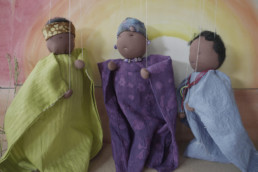

In Fiber Arts teacher Barbara Freiberg’s classroom, Susquehanna Waldorf School’s Class 7 students busily transform lengths of thread and swatches of fabric into playful marionettes for their May performance of “Folktales from Africa.” The work is fun—but it is also grounded in the classwork and the student’s developmental needs.
The marionette play is, as all class plays in Waldorf education are, connected to one of the curriculum blocks. For Class 7, the “Folktales” play reinforces and enriches their study of Africa. Touching on geography, culture and people of the different African regions, the marionettes, alongside other art-centered projects, carry the goal of a deeper experience with the subject matter.
In addition to bringing the curriculum to life, class plays at SWS meet students where they are developmentally and seek to address the struggles felt by the particular age group. Class 7 students entering adolescence, a stage of heightened self-awareness, find comfort in their role working with marionettes, as they can reveal their character behind the scenes instead of out in the spotlight. The teacher is able to stretch the skills and capacity in students this way, but from a place that is comfortable for their age. The play also strengthens the sense of interdependence among the whole class, and uncovers a new appreciation for each other.
As each puppet dances lightly from the marionette strings, Class 7 students smile and recite the lines they have worked diligently to memorize. How they enter their character and respond to each other through practice prepares them for their performance, as well as their final eighth grade production in the coming year, but it also prepares them for life—a gift that goes well beyond the stage.
sws 2017-2018 annual report
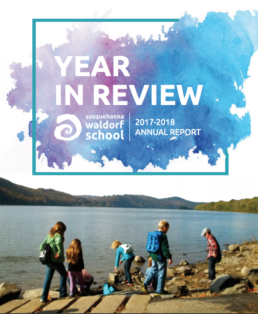

On behalf of the faculty and Board of Trustees at SWS, we are excited to present our 2017-2018 Annual Report. The magic of our school continues to work its wonders in educating and developing the children that have been entrusted to our care. In light of the challenges of our modern world, Waldorf education continues to provide much needed focus on the developmental needs of the child. The results are tangible — one walk through the hallways of our wonderful building makes that apparent.
As always, we welcome input from any member of the school community. We look forward to continuing this journey with our parents, alumni, friends of the school and most important, our children.


